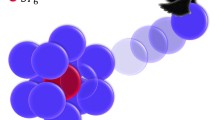Abstract.
Size-selected gold clusters, Au n - (n≤21), and tungsten clusters, W n + and W n - (n=4-8 and 12), stored in a Penning trap have been collisionally activated. Neutral monomer and dimer evaporation are observed in the case of gold. While no fragment products have been observed for tungsten clusters, there is evidence of electron emission from the anions.
Similar content being viewed by others
Author information
Authors and Affiliations
Additional information
Received: 1 September 1998 / Received in final form: 22 November 1998
Rights and permissions
About this article
Cite this article
Weidele, H., Vogel, M., Herlert, A. et al. Decay pathways of stored metal-cluster anions after collisional activation. Eur. Phys. J. D 9, 173–177 (1999). https://doi.org/10.1007/s100530050421
Issue Date:
DOI: https://doi.org/10.1007/s100530050421




